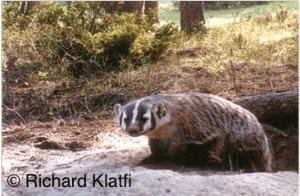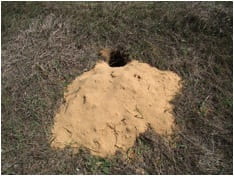Badger Signs
The key to finding badgers is accurately identifying various signs they leave. This section of the website is divided into two sections:
- Commonly confused species that are also found in Wisconsin
- Distinguishing badger burrows
Seeing live badgers in the wild is rare, but we can use evidence of where they were to further understand them. Although they are physically very unique, identification can be difficult without the actual live animal.
Commonly Confused Species
 Badger (Taxidea taxus)
Badger (Taxidea taxus)
- Flattened body with short legs
- Patches of white and black on face
- Central white stripe running from muzzle to shoulders
- Short brownish colored tail
- Triangular ears on the side of the head
- Long front claws for digging
 Raccoon (Procyon lotor)
Raccoon (Procyon lotor)
- Round body with long legs
- Black facial markings form characteristic “mask”
- Long striped tail
- Medium sized ears on the top of the head
- Paws built for grasping
- Frequent road kill
 Skunk (Mephitis mephitis)
Skunk (Mephitis mephitis)
- Long, skinny body with short legs
- Single white stripe that splits at the shoulders
- Long, fluffy tail
- Small, roundish ears on the side of the head
- Medium-sized claws on the front feet
- Frequent road kill, but highly pungent odor
 Woodchuck (Marmota monax)
Woodchuck (Marmota monax)
- Stout body with short legs
- No markings on face
- Short, brownish tail
- Small ears on top of the head
- Large claws for its size, built for digging
- Smaller in size
Distinguishing Burrows
The most common burrows that are mistaken for badgers are woodchuck burrows. Below are common features to both types of burrows. Remember, there are exceptions to the rule, so if you are not sure whether the burrow belongs to a badger or a woodchuck, contact us with a photo and/or description. For more burrow photos and how to determine if a burrow is fresh, please visit the Badger Burrows section of this website.
Badger Burrows
Badgers excavate their burrows by digging with their front paws in a swimming motion. This style of digging and where their burrows are found help distinguish their burrows from woodchucks. Below are some features of badger burrows that are often used to help identify recent diggings.
Outside the burrow:
- Large pile (“plume”) of dirt in front of burrow
- Found on forest or agricultural edges, hillsides, rural roads
- Egg-shaped, wider than it is tall
- About 1 to 2 ft. wide
In the Burrow:
- Scratch marks along the sides (black arrow)
- May find hair at the entrance
- Sometimes have a musky smell near entrance
Woodchuck Burrows
Woodchuck burrows can appear very similar to badger burrows. Probably the best features that distinguish woodchuck burrows are a lack of large scratch marks along the sides and the circular shape of the burrow. Woodchucks are also vegetarians, so any chewed on plant matter in the burrow is indicative of a woodchuck.
Outside the burrow:
- Smaller plume of dirt around the front of burrow
- Found in variety of habitats, grassy fields, backyards, etc.
- Circular, as wide as it is tall
- Under 1 ft. wide
In the Burrow:
- No noticable scratch marks along sides
- General lack of hair at the entrance
- Sometimes partially consumed plants at entrance



